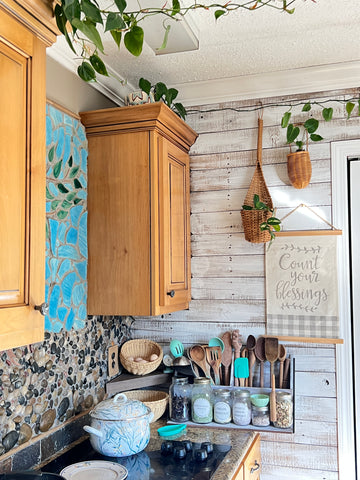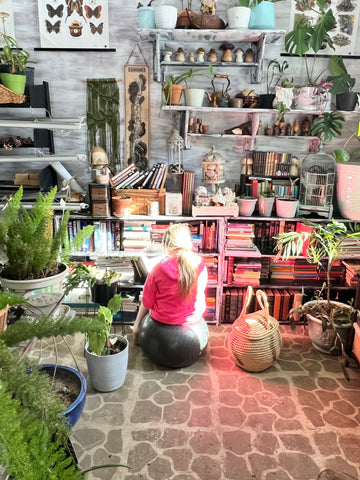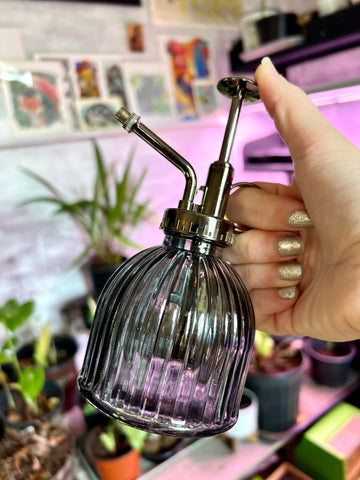6-Step Guide to Keeping Indoor Plants Alive
6-Step Guide to Keeping Indoor Plants Alive
Keeping plants alive in indoors is easy when you know what your pants need to thrive! Winter may also be around the corner and frosty nights mean it's time to overwinter your plants! Chilly temps means that my house is full of extra greenery I had to bring in from their spots on our deck.

Every year my collection grows, and I have to be more creative about where to put all my plant babies. Some of those places might surprise you and could be something you can try!
How can you keep your house plants and tropicals live? Here are my 6-Steps that I follow!
Step 1: Investigate Your Space
Look around your home for a space where your plants will get the most natural light throughout the day. How many hours of natural light will they receive in that spot?

Some of your plants will need more light than others. Think about the temperature of that space. Will they stay warm enough, too cold, or even too hot? Do some of your tropicals need humidity? How will they get it?
You will be surprised by what you can find, even in areas you have yet to consider. Do your plants need to grow up or out, or can they grow across paces?

Several of my pothos plants were getting too long for their containers on top of my kitchen cabinets.So, I decided it was time to create a living plant ceiling!They get plenty of sun from my very large East facing window and warmth from the naturally rising heat in the room. But they were missing one of their favorite things. Tropical vines naturally love to climb so I provide them with a way to stretch out and mimic the feeling of climbing.
Join me on Instagram to see some of our other plant setups!
View this post on Instagram
Step 2: Lighting In Your Home
Why is light so important? Light = Food for your plant friends.

You must figure out what type of light your greenery needs: low light, medium light, or full light. Once you find out what kind of light each plant needs, you can arrange them correctly throughout your home or in a group.

- South-facing windows = equal the highest available light/strongest
- North-facing windows = equal the lowest available light/weakest
- East-facing windows = equal morning sun/ weaker light
- West-facing windows = equal afternoon sun/stronger light
The windows allow natural light to come in, so if you can find a space for your plants in front of them, that's perfect!


If you have minimal window light, you can buy grow lights. They come in all different types and sizes. You can have one hanging on a lamp cord or whole shelving units created for your collection.

Also, keep in mind that they need time to adjust.
Bringing your plants from outside to inside may not seem like a big deal for us, but it can cause a shock for your plant.
You took them out of one environment into something completely different. So they might start to wilt, the color of their leaves may change, or they may even lose leaves.
Don't freak out and begin to overwater or do something in haste. Please read the following tips below to get them on the right start.
Step 3: Plant Care

When you bring your plants in, you can also do some "Plant Care":
- Take this opportunity to give each plant a good look over.
- Cut off any already dead or dying leaves. Wipe down the leaves with a damp cloth to remove dust and dirt. Dust will block sunlight and slow the process of photosynthesis.
- It is also a time to repot or add any specific minerals your plant needs. But be sure to do this in a warmer area, so the roots don't get too cold.
Tip: If your plant looks sick or shows signs of a pest investigation, keep it away from your other plants. You will want to quarantine it for about a month to make sure.
Step 4: Watering Your Plants
I have to admit that this is where I fail. I tend to forget to water my plants during the winter. We forget that when we run the heat in our homes during the winter, it can dry out our plants, so the right about of water is essential!
If you have been a long-time reader or vlog watcher, I recommend using rainwater. Just because it is cold outside, you can still use rainwater. Put a bucket outside.

You can just let the rainfall into it or place it under a gutter to help catch more. You don't want to pour freezing cold water onto your plants, so let it sit until room temperature.

If this is not an option, use filtered water. The filtered water will keep the chemicals out of the water and away from your plants. If it is cold from the fridge, let it sit to get to room temperature.
Step 5: Plants and Temperature
You brought your plants in, so they should be fine. But then some drop their leaves, and others look so sad! It might be the temperature in the room.

It might take a while to discover which room or temperature will be best for your plants. You might put them too close to the window, which might be too cold for them. If you place your plants too close to a vent, the warm air might dry them out.

My oldest figured this out when she put a fern in what is usually an excellent place for the Pothos plant. But a fern is delicate and loves water, so it was not happy being in the rays of a bright skylight tube and vent blowing warm air. The fern is now safely in recovery in a different location.
Step 6: Tropicals Love Humidity
I live in the South, where humidity is constantly in the air outside during May-Oct, where my tropical plants thrive, but inside my house is a different story.

Your tropical house plants will grow larger and more vibrant if given the humidity they love. But most people don't like their houses to feel like a humid tropical jungle, so your plants are missing that moisture they love. Luckily for them, you have three solutions!

Use Cooking Steam:
Place them high above the stove to get the steam created when cooking. The following should be common sense but keep them away from the stove where you will burn them from the heat.

Also, they are not so close that the hot steam will burn them either. I don't have an above-hood vent for my stove, so the mist rises floating across the plants I have above the kitchen cabinets. They love it!
Use Bathroom Steam:
Can't put them above the stove, then the bathroom might be the perfect spot! Like in the kitchen, a warm steamy shower can give your plants that tropical humidity they love. Our bathrooms have skylight tubes which provide the perfect natural lighting.
One bathroom also has a great top shelf, just the right size for sitting pots where they can soak up all the humidity from our daily showers. I've also seen people create shelving beside a bathroom window to get good lighting.

People also hang their plant baskets or macrame potholders from the shower rod. Just make sure they are strong shower rods!
If neither of the above suits you, consider a humidifier. It is common for serious plant collectors to have humidifiers for their tropical plants.
Use Humidifiers
They come in all shapes and sizes and with all kinds of tech abilities. It's not the end of the world; if you can't provide your plants with the proper humidity, they will be okay.
I hope some of these tips will help you grow your plant collection outside or inside. Remember that it is a learning journey!
One thing that can help you in that journey is to record your plants behavior during their stay inside your home. I've created a Winter Plant Care Log to help you make notes and improve your plants and your life in the cold winter months!
Thanks for visiting our Cottagecore Homestead!

